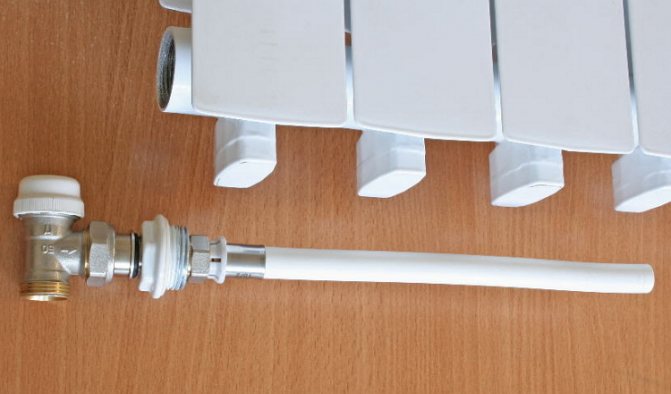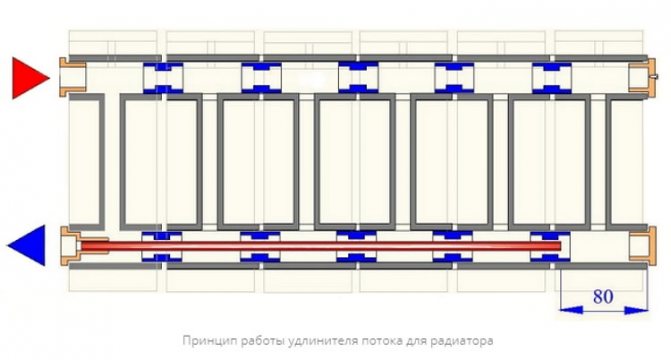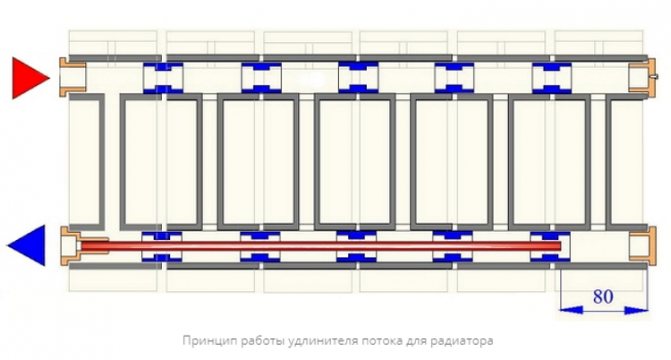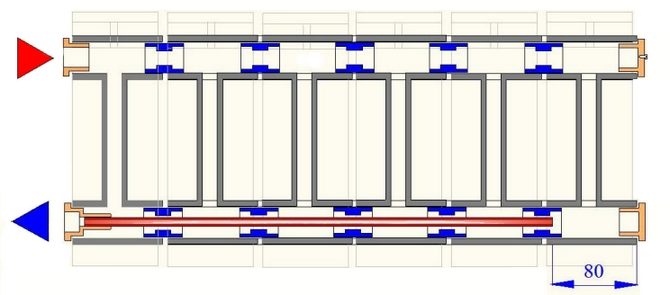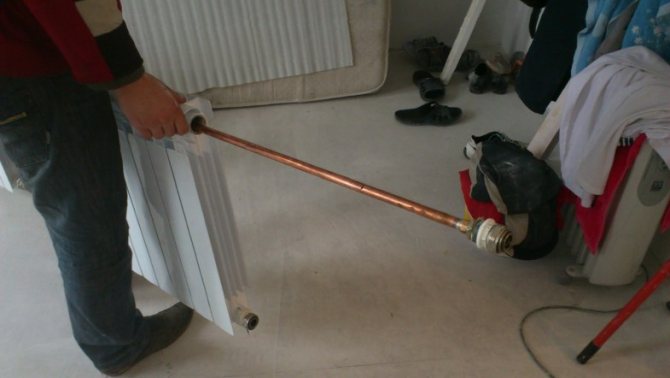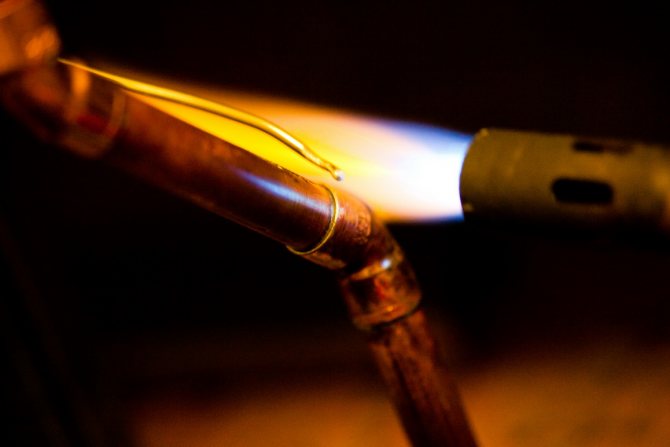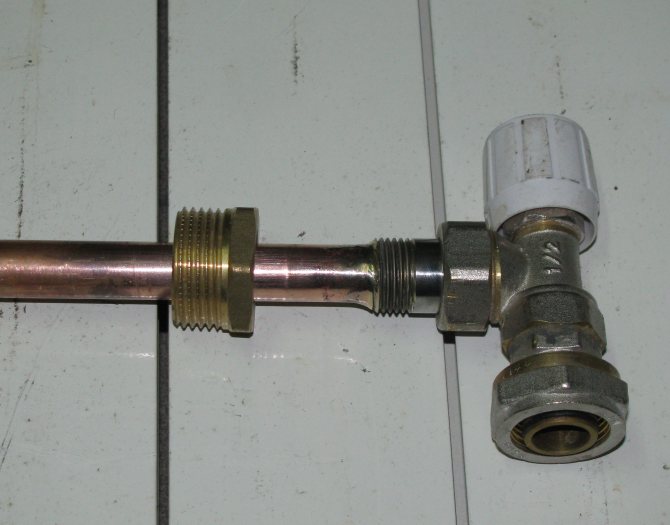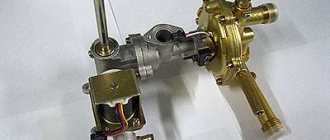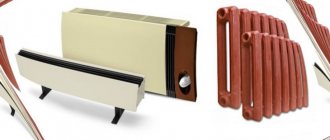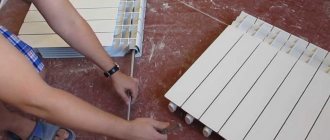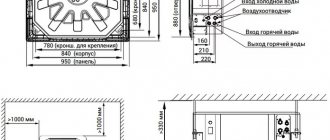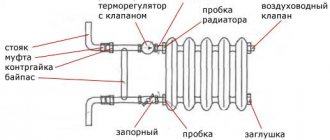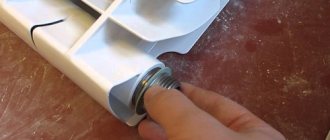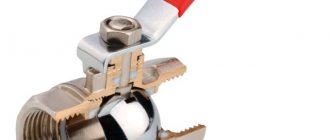Purpose of the flow extension
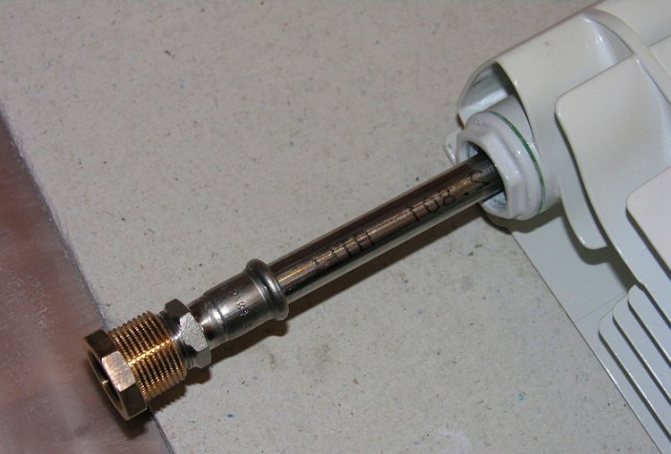
Most often, a flow extension is used with side connection of radiators.
The part is used to change the direction of flow of the thermal medium, which allows the battery to heat up evenly without reconnecting. The duct extension is suitable for radiators connected from one of the sides. Often it is installed on a reverse connection, due to which the water moves diagonally.
Usually the part is used for long batteries (the number of cells is more than 10), since their design contributes to uneven heating. The further the section is from the pipe through which the water is supplied, the more likely it is to remain cold. The easiest way to fix this is to mount an extension cord. This will help make the circulation smooth and efficient. The device is suitable for bimetal batteries (with aluminum and steel components). It is rarely used for cast iron structures.
Radiator design
When choosing radiators, the main focus is on the efficiency and quality of the product. It is also worth considering the types of construction and material of manufacture. Today the range of radiators is quite extensive. It is worth taking into account in what conditions the equipment will be used.
But no matter how well the radiator is chosen, if its length has 10 sections or more, then when connected, it will heat up unevenly. Its productivity will be reduced, since the farther from the supply pipe the heating element is located, the more unevenly the water circulates. Therefore, either they make an inclined connection, or introduce a more efficient method. It is the use of a radiator flow extension, which is well suited for bimetal, aluminum and steel products.
View gallery
But before deciding such issues, it is worth familiarizing yourself with the differences in radiators. Modern heating devices of this type can be made from various alloys. For example, it can be a cast iron, steel, aluminum, bimetallic, copper radiator, etc. They also have a different appearance:
- A panel radiator made of aluminum is perfect for your own heating. Inside there are steel heating panels connected by converter fins. This gives a high rate of efficiency.
- Tubular steel radiators through which hot water flows. This is a simple construction.
- Aluminum radiators. There are two types of them: injection molding and extrusion. It is recommended to use them only for autonomous heating. Due to the nature of the material and the weak atmospheric pressure inside the system, they cannot be used for central heating.
- Cast iron radiators. The very first type of radiators. The heater gains heat for a long time, but it has good heat transfer. Ideal for district heating.
- Bimetallic heating radiators. This construction combines materials of steel (from which the core is made) and aluminum (which covers the shell). They have a sectional design. Such radiators are suitable for both autonomous heating and centralized heating.
A wide range of designs allows you to create a high-quality system under any conditions.
Pros and cons of using


A flow extension with shut-off valves can be made by yourself or bought in a store.
The main advantages of the device are ease of installation and increased efficiency of the heating system.To buy it or make it yourself, you will not need a serious investment. To install the device, it is enough to have basic locksmith skills. Productivity gains are achieved without making adjustments to the existing battery wiring.
The duct extension for a bimetallic radiator has certain restrictions on its use. It can only be installed on radiators connected one-sidedly from the right or left side. They must also be equipped with shut-off valves on the return and water supply side. If this is not the case, the fitting will fail. You will have to contact the wizard and reconnect, which is labor intensive.
Ready-made extension cords are quite rare in stores, but they are easy to make yourself or order via the Internet.
Radiator duct extension
It improves the operation of the heating system and significantly increases the efficiency of heat transfer when radiators with more than 10 sections are connected to the side. This eliminates the problem of uneven heating of the radiators when only the first sections from the riser are hot. The radiator duct extension allows organizing the internal diagonal movement of the coolant without changing the side connection diagram.
Having gathered all this information from reputable sources, I decided to buy a duct extension cord, but it was not there. In specialized stores, sellers made a helpless gesture and did not even hear about such a thing. Later, a Rifar extension cord was found, but it did not meet the required characteristics, and it was decided to make it ourselves. There are no particular difficulties in this.
Diy duct extension
A prerequisite, the radiator must be connected through ball valves with "American". We close the taps, drain the water and dismantle the heating battery.
Carefully, so as not to rip off the paint, we unscrew the top plug with the installed part of the detachable connection.
You may need to replace the silicone gasket under the plug during installation, buy in advance.
Also from the materials you will need:
- The socket is straight for soldering. Outside diameter about 19.5mm.
The first step is to solder the pipe and sleeve. I used soldering grease as a flux and soft solder. We connect the parts and heat both parts with a burner. But a photo, an ordinary small burner fueled with lighter gas.
Extension cord features
The main components of a radiator flow extension are a small (0.5 ”or 0.75”) fitting and tubing attached to it. The latter can be made of different materials - stainless steel, copper, polyethylene or metal-plastic. Copper pipes cannot be used in conjunction with aluminum radiators and parts: when interacting, these metals are oxidized. The part mounted on the reverse connection changes the direction of movement of the coolant so that the maximum efficiency is achieved. This method will be effective for long radiators (0.8 m or more).
Bottom connection features
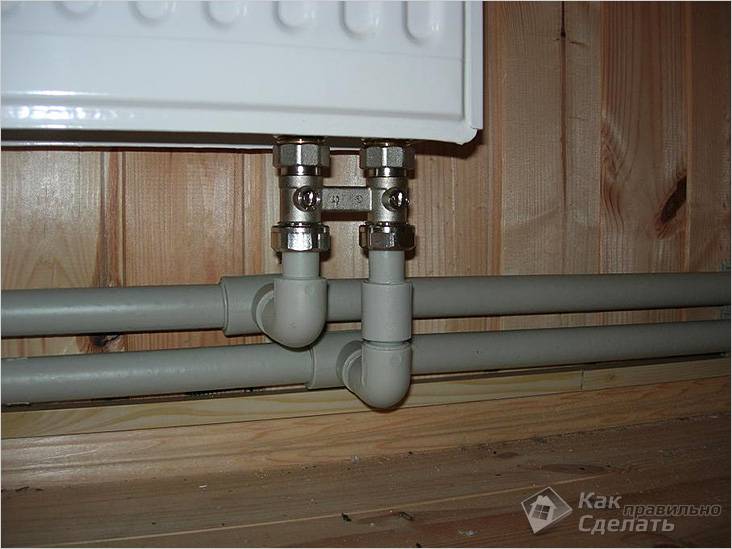

Open type bottom connection
Three ways to connect:
- Connecting ordinary radiators through the bottom holes.
- Using a set of accessories from below, steel or bimetallic radiators.
- Purchase batteries that are designed for this connection.
Now let's look at the ways, pros and cons of different bottom connection methods.
Connection with side taps


Bilateral bottom connection
The connection itself is not very difficult. The pipes are located below - above the floor or hidden in the floor. A radiator is mounted on the wall, and a pipeline is supplied to the lower holes.In order for the battery to be removed without stopping the heating process, shut-off valves must be installed on both sides. An air vent is installed in the upper hole (no matter which side).
Connecting with an adapter
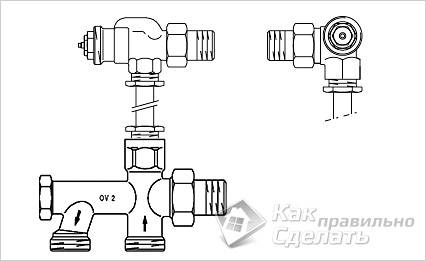

Connection diagram
Sometimes it is not possible to connect an ordinary radiator by bringing a pipeline to it from both sides. In this case, you can use an adapter. It is screwed into the lower hole, and a stainless steel tube is supplied to the upper one from it. The heating pipes are connected to the very adapter from below.
You can get more information about this type of connection by watching the video attached at the end of the article.
Bottom connection with flow extension
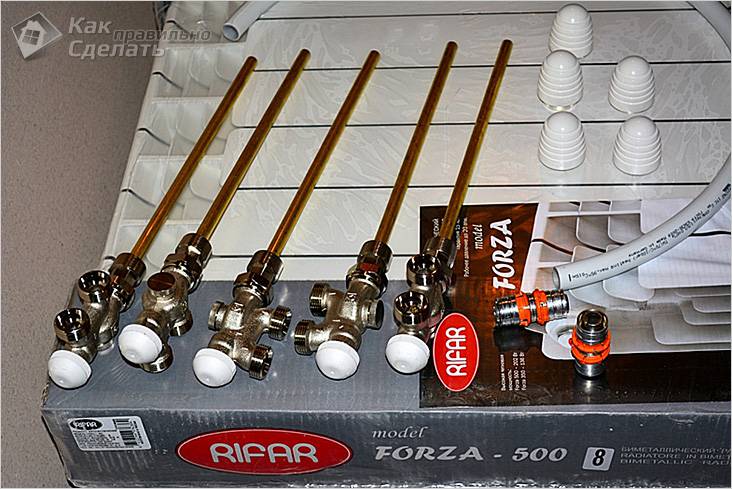

Flow extension
The bottom connection can be made with a flow extension. The device is screwed into the lower hole and does not have any branches to the upper one. The circulation of the coolant occurs due to the fact that water, passing through the tube in the middle of the radiator, leaves it at the end of the heater, rises, squeezing cold water through the outlet located in the device.
This type of connection is not suitable for gravity systems.
Battery connection with bottom lead
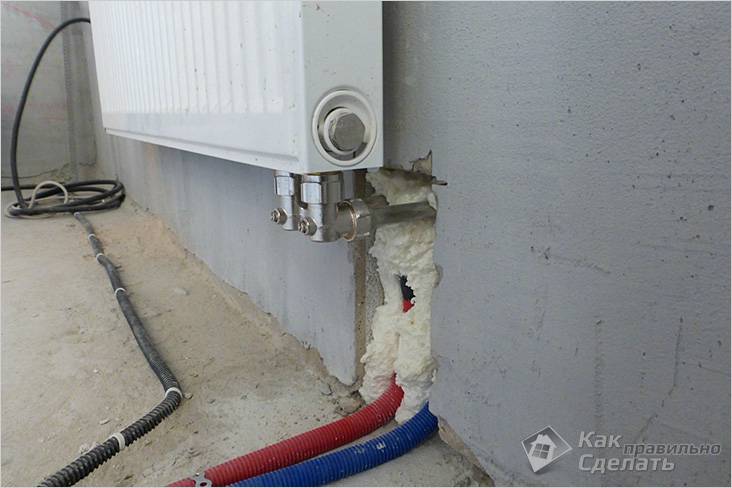

Laying pipes in the wall
Now let's dwell on the more effective and most aesthetically acceptable way of connecting the bottom - from the bottom, along the way describing its advantages and disadvantages.
Benefits


Flow direction adapter
- It is possible to install a flow direction adapter.
- Both pipes go straight from the battery to the floor or wall (or pipes located above the floor).
- When buying radiators with bottom connection, you do not need to worry about purchasing a suitable thermostat, since it is already installed there.
disadvantages


Need to bleed air from the battery
- An air vent must be installed on each battery.
- Warming up is less uniform and less effective.
- Cannot be used for gravity heating systems.
- It is necessary to constantly use a circulation pump.
DIY extension cord


When self-manufacturing, it is better to use a copper pipe.
It is not difficult to make such a design yourself if you have all the required components and a suitable type of battery connection. The cranes through which the radiator is connected must be ball and equipped with American women. They need to be closed and the water drained. Then you can start installation work.
Procedure:
- On one of the lateral sides there is an upper case. It must be unscrewed together with the detachable fastening element mounted there. This must be done carefully so as not to damage the paint coating. Then it is advisable to replace the silicone round. It is possible to dismantle the heating battery completely if it seems more convenient for work.
- Proceed directly to the assembly of the extension structure. The tube cut with a special tool will need to be soldered to the sleeve. First, it is cleaned from the inside from plaque and dirt with a brush. Soldering grease works well as a flux. With a small brush, it is applied on top of a part with a smaller diameter. Then one element is inserted into another and excess fat is wiped off. The joint begins to be heated with a burner until a silvery hue appears.
- After that, solder is applied to it. If the heating is done correctly, the solder softens from the high temperature, flows into the joint area and fills the space. When this happens, you need to wait at least a minute until the molten metal finally solidifies.
- The American woman with the cleaned inner walls has a diameter of 1.9 cm. The clutch has a slightly larger diameter. You can use a small file to remove excess. You need to do this carefully so as not to damage the parts.For clogging, you can use wooden spacers.
- Sometimes you have to experiment with the length of the tube. Sometimes the length to the middle of the radiator is optimal, but it is preferable to start with a longer one. If necessary, the excess length can be cut off later.
The extension device is mounted in the hole and screwed. You also need to replace the gasket and the battery itself. To remove air masses from the system, a Mayevsky crane is used.
Required tools and materials


Installing the flow extension into the radiator
It is necessary to select a piece of pipe that will perform the function of elongation. The thickness of its walls should be at least 1 mm, and the section should be 1.8 cm. The length is taken approximately equal to the length of the heating battery itself. If necessary, it can be shortened in the future. It is important not to forget about the ban on the installation of copper elements in one structure with aluminum ones (including bimetallic radiators with parts made of this metal). Ignoring this rule is fraught with the destruction of all reacting parts of the system.
For installation, you will also need to prepare the following parts and tools:
- Straight soldering socket with an outer diameter of 2 cm.
- A pipe cutter that allows you to evenly cut a piece of extension to the required length without deforming the metal. When working with this tool, the workpiece is kept at a right angle. When the trim is complete, the bumps can be brushed away with a brush.
- Beveller. With its help, burrs are eliminated in the places adjacent to the ends of the tube segment.
- Metal brush and stiff brush.
- Pipe expansion device.
- Solder.
- Soldering torch. A simple device of small dimensions will do; you can fill it with gas used for lighters.
The silicone gasket installed in the connection should also be replaced with a fresh one.
Stream redirection
The situation when the radiator heats up unevenly, and the room is cool, is familiar to many. Often this phenomenon is attributed to the presence of air congestion, but what to do if there is no airiness, and the system is connected correctly, and some of the sections are still cold.
As a rule, for such complaints, the masters from the heating network will offer to reconnect the heating batteries, but it costs a lot of money, it will make changes in the interior, and it will take time, which is not there at the height of the heating season.
A flow extension for a bimetallic radiator with a side connection type can help in such a situation. This device is used to increase heat transfer and redirect the coolant flow, but it can only be used in structures of 10 or more sections.
The main task of the device is to change the direction of movement of the coolant so that it begins to flow diagonally. This contributes to uniform heating of all sections of the radiator without reconnecting it to the heating network.
An important requirement for the installation of the device is a tap for bimetallic radiators, which connects them to the pipes of the heating system. If there is no shut-off device on the return and supply pipe, then it will not be possible to connect the flow extension, and the only way out is to completely reconnect the battery.
The big drawback of this device is its absence on store shelves, both virtual and real. This is due to the low demand among consumers for such a design, which makes it unprofitable for production, but this does not mean that it cannot be manufactured independently.
You will need a piece of plastic pipe, which must be placed in the radiator return manifold. To do this, you need to shut off the coolant supply, drain the water from the battery and remove it. With the help of a flux, the pipe is fastened to the branch pipe and placed in the return manifold, where, when the coolant is supplied, even under a weak pressure, it will have to pass through all the sections of the battery each time, thus warming them up.
The length of the tube should be equal to the length of the radiator, minus one of its sections. In the event that only the middle elements of the system are not warmed up, an extension cord is not needed, since the cause of poor heating is the clogging of the conducting channel. In this case, you will have to flush or replace the section.
Popular manufacturers


Rifar radiators are sold with ready-made flow extensions
Well known flow extenders for bimetal batteries are from Valtec. This Russian-Italian company produces products for uniform heating of multi-section radiators. Fittings are made of brass and nickel plated. They have an external thread of 1 inch and a branch pipe designed to connect to a pipe of 1.6 or 1.8 mm. In the catalog there are small-sized options in 0.5 and 0.75 inches. Parts with right-hand and left-hand threads are produced.
The domestic company Rifar mainly produces sectional radiators made of bimetal and aluminum. Suitable extension cords are available for different battery models. Most are 0.75 "in size.
The lengthening of the flow will be an excellent solution in a situation where the sections of the convector far from the supply remain unheated. The device has a low price and is easy to make at home. Suitable for sectional radiators with a length of more than 0.8 m and connected on the right or left side. When buying or making it yourself, you need to pay attention to the compatibility of parts made of different metals.
Using a duct extension
What it is
- If there are more than 10 sections in the radiator, then there is a possibility that, when connected to the side, they will heat up unevenly, that is, the farther the section is from the supply pipe, the colder the coolant will be in it, since the circulation in the heater will pass at different speeds. Therefore, in order not to redo the lateral connection to a diagonal one after installing the battery, which can cause certain problems with the arrangement of the interior of the room, you can install a duct extension for radiators with your own hands.
- After installing such a device, the circulation of the coolant takes on a uniform character. - the internal diagonal movement of water begins to pass at the same speed and thus the problem of uneven heating of the battery is removed by itself.
But it turns out that not everything is as simple as it really should be - the fact is that buying a duct extension cord in a plumbing store or even ordering it on the Internet is a whole problem and the reason is the most commonplace - no, not a high price , but their absence. But for those who have a desire to equip their life, we solve this issue - the adaptation can be made independently.
Do it yourself
In order to perform such a manipulation with the radiator, there is one important condition, which, however, must be fulfilled for very many situations - this is the presence of shut-off valves on the supply and return pipes, where ball valves and "American" valves will be connected.
To dismantle, first of all, you need to turn off both taps and carefully unscrew the upper left or right foot - there is a possibility that the silicone gasket will be damaged, therefore, it is best to buy it in reserve - fortunately, it has a penny cost. Of course, it is best if you completely free the battery from the pipes and remove it from the brackets - it will be much more convenient for you to carry out further work on the floor.
